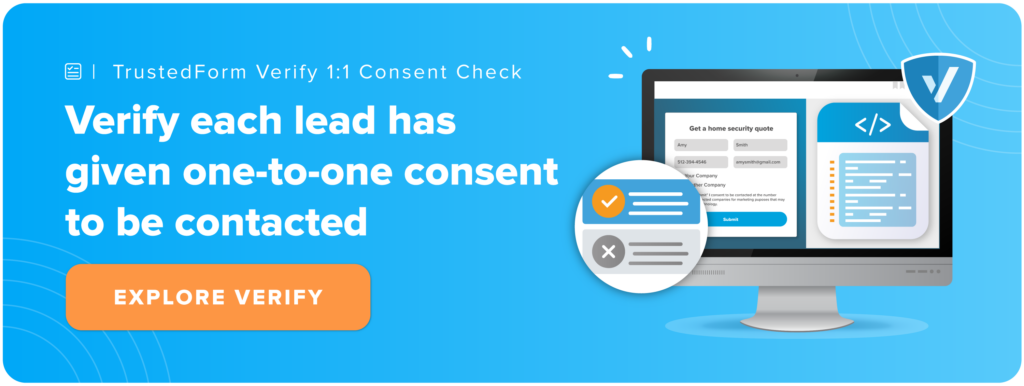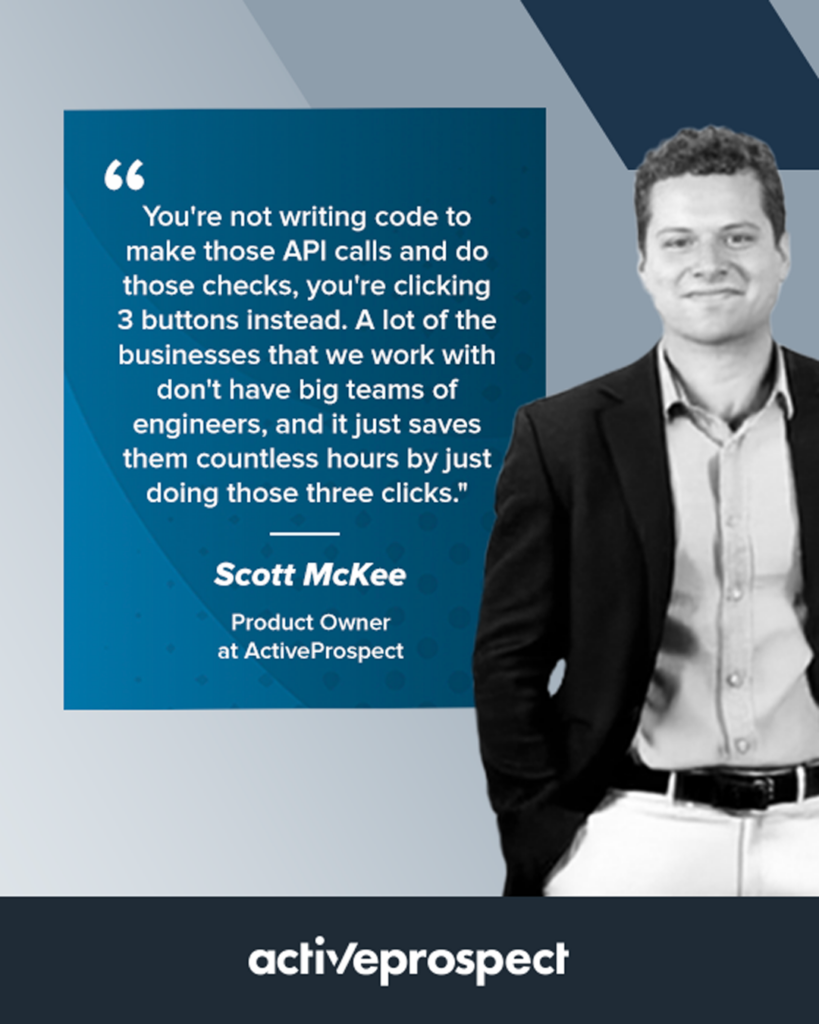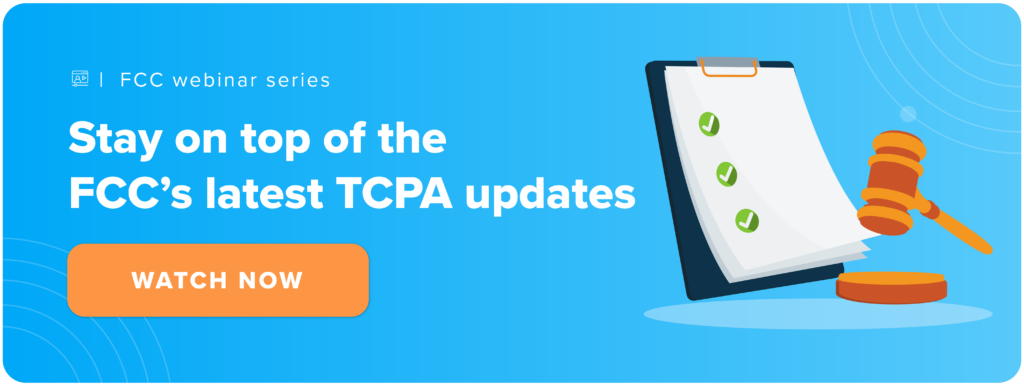Empowering your business for compliance and efficiency with LeadConduit

In the 20th episode of our FCC webinar series, “LeadConduit 101: The plug-and-play strategy for 1:1 compliance,” our Product Owner, Scott McKee, our Senior Client Success Manager, Dion Green, and our Sales Development Representative, Jacob Hollifield, take us on an insightful exploration of ActiveProspect’s tools, LeadConduit and TrustedForm Verify.
See how to use them to effectively collect, manage, and verify lead data, and how to integrate them with existing CRM systems and marketing platforms, in order to comply with the FCC’s upcoming one-to-one consent requirement.
Introducing LeadConduit
LeadConduit is part of ActiveProspect’s suite of products and it streamlines your lead acquisition process to efficiently acquire customers at scale, without needing a large engineering team.
LeadConduit’s low-code approach simplifies integrations and technical tasks, ensuring you only acquire the right leads for your business.
Custom lead flows automatically enhance and filter leads in real time to deliver the highest-quality prospects to any system you choose, whether it’s your CRM, autodialer, data warehouse, or another platform. It’s all about getting your leads to the right place, seamlessly.
LeadConduit also streamlines how you receive information from various vendors. For instance, as Scott explains, one vendor might label a field as “Company,” while another uses “C name.” LeadConduit standardizes this data, making it easy to manage. It ensures that “Company name” is sent to the appropriate field in any system you’re using, significantly reducing technical overhead.

What if you handle both first-party and third-party leads?
As Jacob explains, first-party leads are those you generate through your website, while third-party leads come from aggregators or other purchased sources.
As both Dion and Scott agree on, when implementing these different leads in LeadConduit, it’s typically best to have two separate flows: one for first-party leads and one for third-party leads. This makes tracking information easier.
For third-party leads, you usually don’t need different flows for each partner. LeadConduit aims to simplify processes, so if the data delivery format is standard across partners, a single third-party flow should suffice. As Scott explains, our customers successfully use one flow for all third-party leads and another for first-party leads.
LeadConduit’s low-code approach allows you to treat these leads differently with just a few clicks, without needing engineers to write complex code.
How can LeadConduit help with the updated FCC regulations?
With the recent FCC ruling, many people are concerned about a potential decrease in lead quantity. While the extent of this decrease is uncertain, as Dion explains, it’s crucial to focus on lead quality. LeadConduit simplifies the process of extracting and assessing lead information. You can easily export data to analyze metrics like contactability and set rates, helping you define what constitutes a high-quality lead.
LeadConduit also offers integrations with services like Blacklist Alliance, Contact Center Compliance (DNC.com,) and Anura to check for known litigators, attorneys, and fraudulent activity. This appended data can be seamlessly pushed to your CRM. Additionally, you can set up batch file exports to receive this information at regular intervals, making it easy to assess with your team.
As businesses prepare for the FCC changes, we support Ping Pick Post for lead buyers. As Scott explains, this feature allows vendors to check if a lead is a duplicate before submitting it, ensuring data remains anonymous and secure. If a lead is a duplicate, vendors can then decide how to best monetize it. This functionality is becoming increasingly common as users prepare for the FCC’s one-to-one consent changes in the new year.
How effectively does LeadConduit integrate with existing CRM systems and other marketing platforms?
As Scott explains, if you visit our website’s LeadConduit section today, you’ll find our add-ons like Blacklist Alliance and Contact Center Compliance, services which we resell for your convenience. But we also offer pre-built integrations with popular CRMs like Salesforce, for example, making setup a breeze.
However, we understand that new, industry-specific CRMs and systems constantly emerge. That’s why LeadConduit can easily integrate with any REST or SOAP API, allowing you to send leads to virtually any system. If a new CRM gains traction, we’ll add it to our pre-built integrations for quick setup. But even if we haven’t yet, LeadConduit can likely integrate with it now. Our support and implementation team is always ready to assist with your integration projects, as long as the system has an API.
Introducing TrustedForm Verify
TrustedForm Verify helps you mitigate risk by confirming that your requirements for the disclosures used to obtain prior express written consent are satisfied and presented digitally in a one-to-one manner to scale your auditing capabilities.
As Dion explains, TrustedForm Verify consolidates all consent language into a single user interface, eliminating the need to click through individual certificates. Within this interface, you can quickly approve or reject consent language with just a few clicks, saving significant time.
For a more proactive approach, as Dion suggests, you can even review and pre-approve language from your partners in advance, in consultation with your legal team. Additionally, the latest version of TrustedForm allows you to skip activities within certificates, making it even more efficient to understand the consumer’s journey without watching the entire replay of the interaction.
Moreover, we’ve recently introduced the 1:1 Consent Check feature in TrustedForm Verify. This feature enables you to programmatically verify that each lead has given one-to-one consent to be contacted by your specific brand, helping you comply with the latest FCC regulations in a scalable manner.
While there’s some initial backend setup required from partners, the result is a swift and convenient way to verify your company’s presence on the form.

How to integrate TrustedForm with LeadConduit
As Scott explains, with LeadConduit, users process leads from various sources and send them to their CRMs. To start verifying consents, they simply set up their consent language in TrustedForm Verify and click a button to add it to their flow. After entering their business name and saving, all leads passing through that flow are checked by TrustedForm Verify and ideally retained with TrustedForm Retain.
This process requires no coding; just three button clicks. As Scott shares, many of our clients don’t have large engineering teams, so this saves them significant time and simplifies the process.

And the best part of this process is, as Dion says, “all of that happens in real time so that you still keep that speed-to-lead and don’t have any issues there.”
How easy is it to use LeadConduit?
As Dion explains, using LeadConduit is incredibly straightforward, even for those who aren’t tech-savvy. At ActiveProspect, you’ll be assigned an onboarding specialist to assist with initial setup, and customer success managers like Dion are always available to answer any questions.
Making changes is typically just a few clicks away. We also offer an extensive knowledge base where you can find answers to almost any question, from understanding TrustedForm and LeadConduit to implementing add-ons and real-time bidding. You don’t need to be a tech expert to use LeadConduit effectively.
How can LeadConduit assist with compliance with the new TCPA rules?
As Dion explains, with TrustedForm integrated into LeadConduit, not only can you verify consent, but you can also automatically retain TrustedForm certificates for long-term access.
This ensures you have a durable record of the consumer consent, including session replay, which is retained in one simple step within the platform. The certificate link is then passed to your CRM along with the rest of the data. This way, you have a link in your CRM that you can access at any time for up to 5 years, covering the statute of limitations and allowing you to review the playback if any litigation issues arise in the future.

Takeaways
Here are some key takeaways from our webinar “LeadConduit 101: The plug-and-play strategy for 1:1 compliance,”:
- LeadConduit is a lead flow software that allows businesses to create custom workflows for their leads with a low-code approach.
- LeadConduit can integrate with any system with an API, making it easy to append additional data to leads and ensure they are delivered to the right place.
- TrustedForm Verify can help businesses comply with the FCC’s one-to-one consent requirement by checking the consent language on forms.
- LeadConduit can integrate with various services such as Blacklist Alliance, Contact Center Compliance, and Anura to check for known litigators or fraudulent leads.
Watch the entire episode now and make sure to never miss a TCPA update!

DISCLAIMER: This page and all related links are provided for general informational and educational purposes only and are not legal advice. ActiveProspect does not warrant or guarantee this information will provide you with legal protection or compliance. Please consult with your legal counsel for legal and compliance advice. You are responsible for using any ActiveProspect Services in a legally compliant manner pursuant to ActiveProspect’s Terms of Service. Any quotes contained herein belong to the person(s) quoted and do not necessarily represent the views and/or opinions of ActiveProspect.

